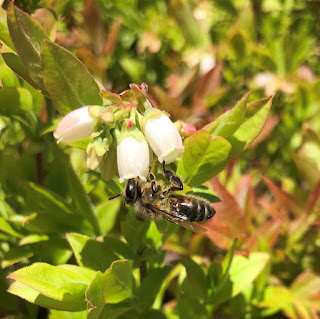Atlantic Canada is known for its delicious, locally grown wild blueberries. However, growing blueberries can be complicated, and relies on pollinating insects such as honey bees. In this blog, we will discuss wild blueberry flowers and how they are pollinated. We will also give a quick update on ATTTA’s wild blueberry research and the next steps in one of our exciting projects.
Pollination of Wild Blueberries
Each individual wild blueberry plant is
called a clone and can grow to around knee height. The leaves are overt and oval-shaped
with smooth edges. The flowers grow in clusters and the corolla (petals) take
on a bell shape with greenish-white or pinkish coloring. Protected inside the
flower are multiple stamens containing anthers that hold pollen (male reproductive
cells). At the base of the flower are the ovary and ovules. Extending out of
the flower is the style that ends at the stigma. Due to the shape of the
flower, wind is not considered a pollinating factor. This means insects are the only way
pollination can occur.
During the wild blueberry bloom in warm
months of May and June, the stigma responds to movement created by attracted
insects causing the anthers to release pollen. Therefore, when a honey bee or
bumble bee visits a flower, released pollen attaches to their body hairs to be
transported to subsequent flowers they visit. This transport is essential as it
distributes male reproductive cells from one individual blueberry plant to
another. This allows for the
reproduction of the plant and the forming of fruit. After an individual flower
has reached the end of its blooming period, the petals fall off, leaving the
green ovary and ovules. If pollinated adequately, the process of fruit set will
begin as the ovary matures into seeded fruit. It starts with bloating of the ovary
as a small, round, white-green fruit, ripening to a dusted blue shortly afterwards.
Figure 3. Fruit set after successful
pollination and resulting from the swelling of the ovary, immature fruit is
shown as well as one ripe blue berry (ATTTA©2022)
Pollination is key to fruit set on wild blueberries, making it essential to have an abundance of pollinators on blueberry fields. Here in Atlantic Canada, honey bees and bumble bees are commonly tasked with this critical job. Managed honey bee colonies are easily added to fields, bringing an abundance of pollinating capacity. Colonies brought in should be appropriately strong and ideally provide at least one forager bee per square yard (Drummond. 2002). This will, among other factors, help determine the stocking density of honeybee colonies needed for individual fields.
Honey bees provide adequate numbers to
pollinate multiple blueberry flowers and have small bodies that can get inside
the bell-shaped flower and shake the pollen loose. Managed or native bumble bees
are phenomenal and unique pollinators, as well. Their size and buzzing ability
effectively shake out pollen and distribute large quantities from one clone to
another. Their extra-long tongues allow them to access and pollinate some of
the more closed-off flowers that honey bees may not be able to reach. They are
also more resilient to pollinating across a broader range of weather
conditions. In spite of being less efficient individually, honey bees have the
sheer numbers to pollinate many flowers.
Now that the fruit is beginning to develop on blueberry fields, the Atlantic Tech Transfer Team for Apiculture will be continuing with one of our ongoing pollination projects. In May, we visited wild blueberry fields in NB, NS, and PE to assess honeybee hive strength and percent bloom. In the upcoming weeks, we will return to these fields and evaluate the number of open blooms which have transformed into fruit. This determination is called fruit set and is an indication of pollination success. This measure in addition to others, such as number of berries at harvest, fruit weight and seed counts, allows us to evaluate the impact that honey bees have ultimately on the final yield. Stay tuned for updates on this work as the season progresses!
Written by Rebecca Campbell, ATTTA Summer Research Assistant rcampbell@perennia.ca
Drummond, F.A. 2019. Over-informed on IPM - Episode 006: Wild Blueberries and Their Wild Pollinators. University of New Hampshire. https://extension.unh.edu/blog/2019/05/over-informed-ipm-episode-006-wild-blueberries-their-wild-pollinators.
Drummond, F.A. 2002. Honeybees and blueberry pollination. University of Maine Coop. Ext. Wild Blueberry Bulletin No. 629.
Connecting with ATTTA Specialists
If you’d like to connect with ATTTA specialists or learn more about our program, you can:
visit our website at https://www.perennia.ca/portfolio-items/honey-bees/
Email abyers@perennia.ca



